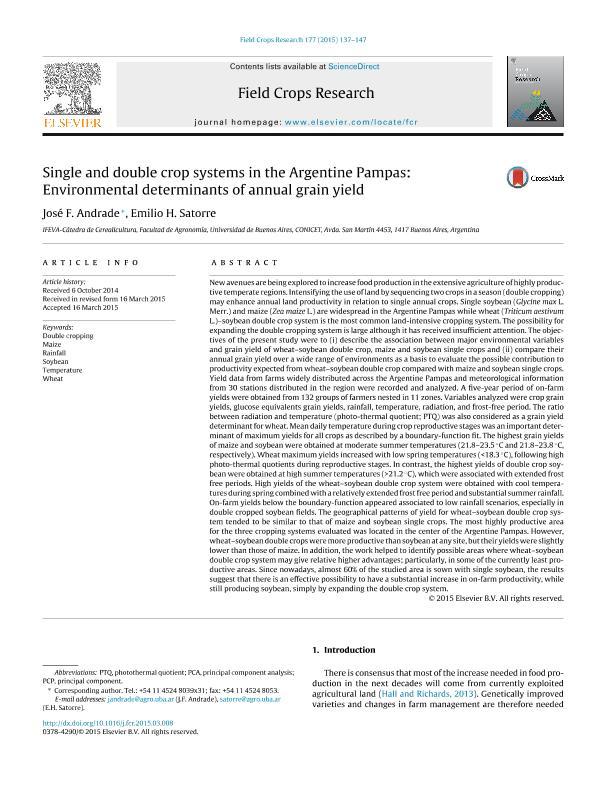Artículo
Single and double crop systems in the Argentine Pampas: environmental determinants of annual grain yield
Fecha de publicación:
06/2015
Editorial:
Elsevier Science
Revista:
Field Crops Research
ISSN:
0378-4290
Idioma:
Inglés
Tipo de recurso:
Artículo publicado
Clasificación temática:
Resumen
New avenues are being explored to increase food production in the extensive agriculture of highly productive temperate regions. Intensifying the use of land by sequencing two crops in a season (double cropping) may enhance annual land productivity in relation to single annual crops. Single soybean (Glycine max L. Merr.) and maize (Zea maize L.) are widespread in the Argentine Pampas while wheat (Triticum aestivum L.)–soybean double crop system is the most common land-intensive cropping system. The possibility for expanding the double cropping system is large although it has received insufficient attention. The objectives of the present study were to (i) describe the association between major environmental variables and grain yield of wheat–soybean double crop, maize and soybean single crops and (ii) compare their annual grain yield over a wide range of environments as a basis to evaluate the possible contribution to productivity expected from wheat–soybean double crop compared with maize and soybean single crops. Yield data from farms widely distributed across the Argentine Pampas and meteorological information from 30 stations distributed in the region were recorded and analyzed. A five-year period of on-farm yields were obtained from 132 groups of farmers nested in 11 zones. Variables analyzed were crop grain yields, glucose equivalents grain yields, rainfall, temperature, radiation, and frost-free period. The ratio between radiation and temperature (photo-thermal quotient; PTQ) was also considered as a grain yield determinantfor wheat. Mean daily temperature during crop reproductive stages was an important determinant of maximum yields for all crops as described by a boundary-function fit. The highest grain yields of maize and soybean were obtained at moderate summer temperatures (21.8–23.5 ◦C and 21.8–23.8 ◦C, respectively). Wheat maximum yields increased with low spring temperatures (<18.3 ◦C), following high photo-thermal quotients during reproductive stages. In contrast, the highest yields of double crop soybean were obtained at high summer temperatures (>21.2 ◦C), which were associated with extended frost free periods. High yields of the wheat–soybean double crop system were obtained with cool temperatures during spring combined with a relatively extended frostfree period and substantial summer rainfall. On-farm yields below the boundary-function appeared associated to low rainfall scenarios, especially in double cropped soybean fields. The geographical patterns of yield for wheat–soybean double crop system tended to be similar to that of maize and soybean single crops. The most highly productive area for the three cropping systems evaluated was located in the center of the Argentine Pampas. However, wheat–soybean double crops weremore productive than soybean at any site, buttheir yields were slightly lower than those of maize. In addition, the work helped to identify possible areas where wheat–soybean double crop system may give relative higher advantages; particularly, in some of the currently least productive areas. Since nowadays, almost 60% of the studied area is sown with single soybean, the results suggest that there is an effective possibility to have a substantial increase in on-farm productivity, while still producing soybean, simply by expanding the double crop system.
Palabras clave:
Double Cropping
,
Maize
,
Rainfall
,
Soybean
,
Temperature
,
Wheat
Archivos asociados
Licencia
Identificadores
Colecciones
Articulos(IFEVA)
Articulos de INST.D/INV.FISIOLOGICAS Y ECO.VINCULADAS A L/AGRIC
Articulos de INST.D/INV.FISIOLOGICAS Y ECO.VINCULADAS A L/AGRIC
Citación
Andrade, José Francisco; Satorre, Emilio Horacio; Single and double crop systems in the Argentine Pampas: environmental determinants of annual grain yield; Elsevier Science; Field Crops Research; 177; 6-2015; 137-147
Compartir
Altmétricas




